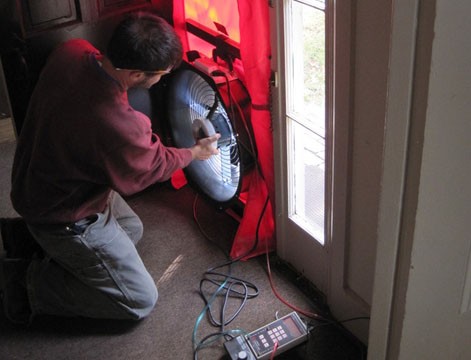Qualifying members get access to expert old-house advice.
Learn MoreRead our best practices to weatherizing historic properties.
These published articles are packed with information for owners of old houses who want to learn more about increasing the energy efficiency of their homes while maintaining their historic integrity:
The case studies below illustrate how environmental sustainability and preservation come together at Historic New England sites.

The Lyman Estate mansion in Waltham, Massachusetts, underwent preservation work and system upgrades to become an energy efficient historic building. The project reduced energy consumption by more than fifty percent while still adhering to the preservation philosophy that defines Historic New England. We hope to demonstrate how owners of old houses can achieve significant savings in energy without sacrificing the elements and details that give character to their buildings. The project followed these basic steps:
Testing and Energy Audits: An energy audit is an assessment of the many different factors that contribute to the energy efficiency of a structure. Although it can take many forms, an audit should look at the facility’s energy use to understand consumption and identify conservation measures that might help the homeowner save money. Energy conservation measures typically focus on decreasing the amount of air getting into the building, because cold air will be drawn into a warm building, making it more difficult to heat, and smart use of insulation. An energy auditor might use blower doors, a giant fan that helps determine how much the building is leaking air, and infrared cameras that help pinpoint otherwise undetectable areas of air leakage and heat loss.
Establishing a baseline of energy consumption was important for the Lyman weatherization project. If we are to achieve a fifty-percent reduction in energy then we need to understand our history of use. An auditor analyzed the energy data, performed blower door tests, and crunched the numbers on the work we were proposing in order to estimate the benefits on energy consumption. Although this established the baseline, we performed these tests at different stages of the project to understand how each conservation measure affects energy efficiency. This information will prove very valuable to homeowners trying to determine how to begin this process.
Air Sealing and Insulation: Air sealing and insulation go hand in hand as weatherization measures. Smart, controlled use of both techniques can drastically change the energy consumption of a building. But buyer beware: historic buildings are very, very different from modern buildings and any action you take should be carefully considered. The biggest pitfall in a historic house is the promise of wall insulation. Homeowners predicting big savings enlist contractors to fill their walls with insulation. But if the conditions are not right and the wall construction does not include proper water barriers, homeowners run a high risk for mold, mildew, and rot.
Although wall insulation was not part of the project, air sealing and insulation were major components. In keeping with our preservation philosophy, these techniques were executed in a way that is reversible in the future. That means we will be able to remove any materials we add some time in the future and be left with the original historic fabric unharmed. Some products used in home efficiency projects are new. Their long-term performance is not yet understood, and they are designed to be permanent and not reversible. We insulated the attic to “cap” off the building and help contain heat. We are experimenting with air sealing techniques that are reversible and therefore suitable for historic properties.
Efficient Heating Systems, Equipment, and Smarter Use: As part of the weatherization project we worked to improve the heating plant of the mansion at the Lyman Estate using the following measures:
Most importantly we need to analyze how we use the spaces and how we manage energy. Read more about our approach to energy efficiency.
 Reducing Energy Use at Pierce House
Reducing Energy Use at Pierce HouseHistoric New England implemented a number of small measures to increase energy efficiency at Pierce House (1683) in the Dorchester neighborhood of Boston, and subsequent tests showed that the improvements paid off.
Air leakage is a major factor in energy waste. Cold air infiltrates a house and causes the heating system to expend more energy to keep the house warm. In order to reduce air leakage, Historic New England staff re-pointed the foundation of Pierce House and implemented minor, reversible repairs to decrease the flow of air through the many nooks and crannies found in an old house. We also installed interior storm windows.
Repeating the same blower door tests that were performed before the project began, we determined that our simple methods reduced air leakage at Pierce House by thirty percent. This demonstrates how homeowners can use simple techniques to reap big results.
Historic New England supports sustainable farming activities. At our two Rhode Island farms we are strongly committed to locally produced organic foods. Casey Farm in Saunderstown operates a Community Supported Agriculture (CSA) program and hosts a weekly market for local farmers. Watson Farm in Jamestown raises grass-fed, heritage-breed cattle and sheep.